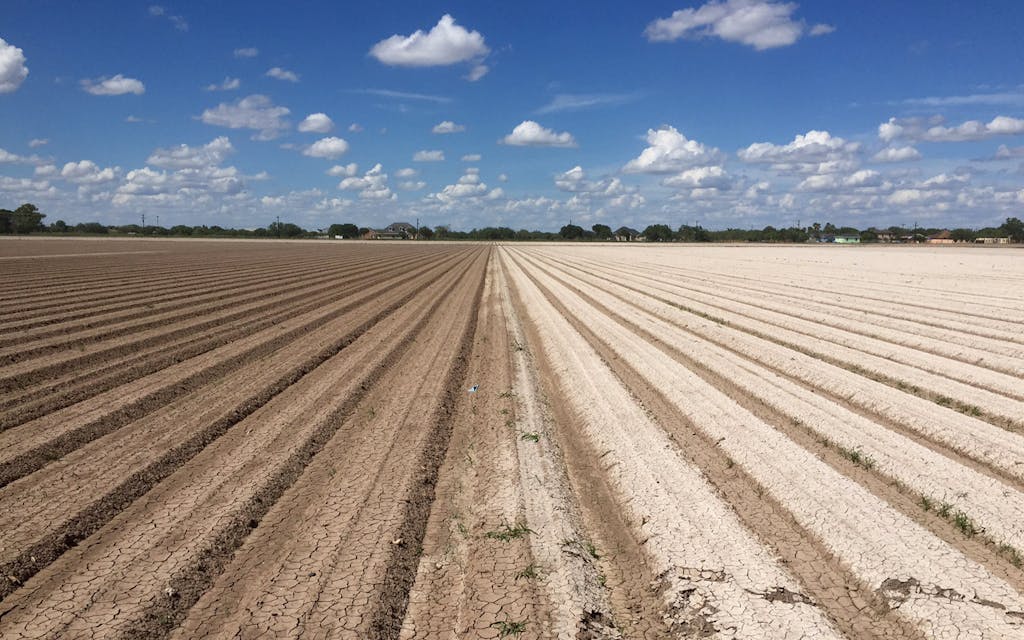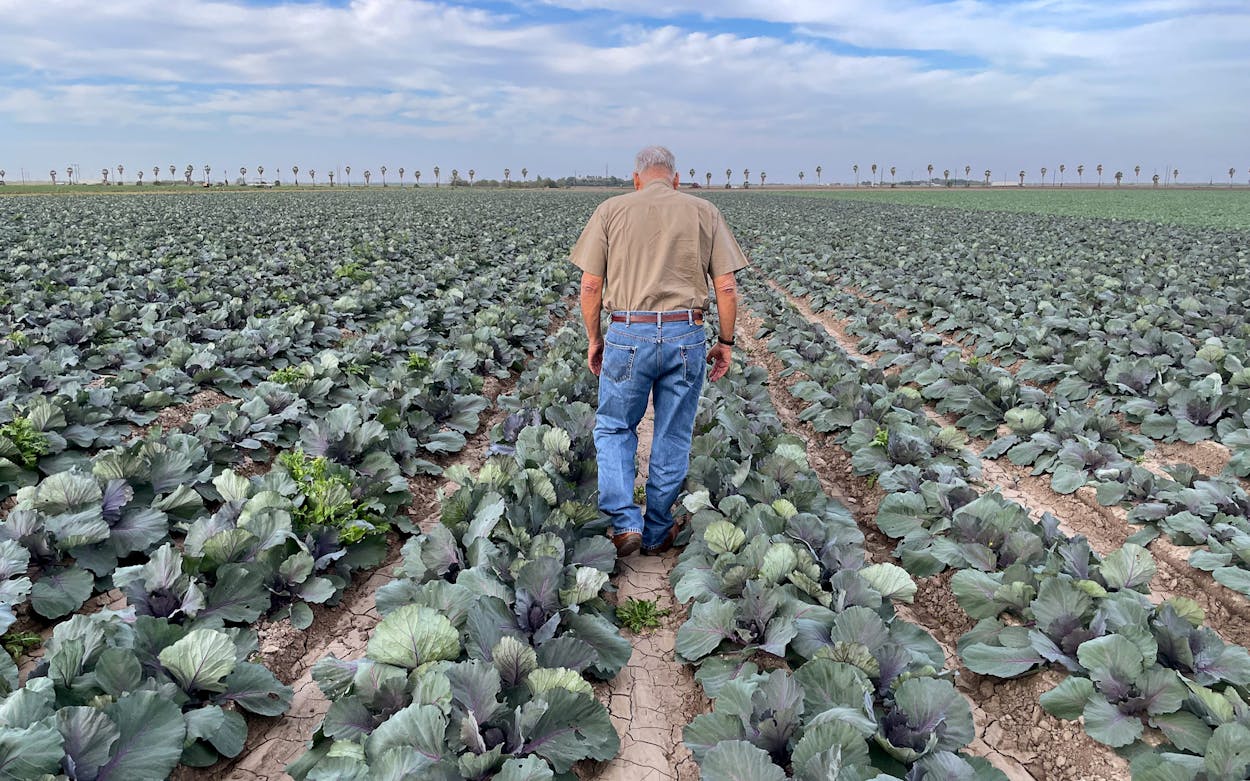Frank Schuster’s three-thousand-acre farm lies on the edge of the Rio Grande, punctuated by the rust-colored border wall that cuts through his cropland. Schuster has been tending his land near Pharr, Texas, since 1977, when his father’s early death left him in charge of the family farm at age 24. Now 71, he still pumps the waters of the river into the furrows of his crop rows of cabbages, onions, and turnips.
Like the majority of the farms in the semiarid Lower Rio Grande Valley, Schuster’s Val Verde Vegetable Co. depends on the river to sustain crops in the state’s most productive region for vegetables. Without the Rio Grande, farmers would be forced to survive on the area’s sporadic rainfall. “Irrigation from the river built the Rio Grande Valley,” Schuster said. “Irrigation made this a jewel down here.”
But as that water supply continues shrinking under the twin forces of climate change and Mexico’s increasing water use, farmers in the Valley have been wrestling with a new challenge. The river has been undergoing sporadic spikes in salinity, causing the water to run salty for days to weeks at a time—a natural consequence when salts concentrate in a depleting river. When farmers saturate their fields with salty river water, plant roots struggle to absorb moisture, which can harm vegetable quality and reduce overall yields. Over time, the land itself can become barren.
On average, the Rio Grande flows with a baseline salinity level between 650 parts per million and 850 ppm, according to data from irrigation districts. But farming in the region is most challenged when salinity spikes beyond 1,200 ppm—the threshold at which sensitive vegetable crops begin to suffer. In 2020, Schuster said, one such spike proved disastrous. That year, salinity levels regularly reached a brackish 2,000 ppm, double the U.S. Geological Survey’s standard for fresh water. After just two irrigation sessions, Schuster’s farmland turned chalk white. Vegetable yields fell by up to 40 percent on some fields, he said. “In August, you’re irrigating multiple times to get your crop up because you’re fighting the heat,” Schuster said. “That year we were fighting the heat and fighting the salt.”
Without other sources of water in the semiarid region, high salinity levels in the river leave farmers with little choice but to either deal with stunted crops or pray for drought-busting rains. “In this business, you manage what you can manage, then hope the unmanageable doesn’t wipe you out,” Schuster said.
It’s an environmental issue that Texas can do little on its own to solve. Any proposal will require collaboration with Mexico. Solutions could range from costly capital projects, such as building desalination plants, to changes in water-management practices, such as introducing strict irrigation schedules. But complicating such collaboration are long-standing tensions between the two nations, stemming from an eighty-year-old treaty that dictates how the U.S. and Mexico divvy up the quantity of water flowing down the Rio Grande.
The challenge, policymakers say, is to navigate the choppy political waters to improve the quality of a river on which both nations depend. “There are so many ways in which we can’t and don’t work together,” said Eddie Moderow, who leads the Border Affairs unit of the Texas Commission on Environmental Quality (TCEQ). “Water quantity is one where it’s getting really tough. But with water quality in the lower Rio Grande, both sides share the same water—we have these shared incentives.”

The treaty of 1944 was negotiated between the U.S. and Mexico after a long history of political conflict over shared water resources. It governs water allocations for the three binational rivers that have been key to the development of the arid Southwest: the Colorado River, which flows into Mexico intermittently via Arizona, the Tijuana River, which flows from Mexico into Southern California, and a roughly 1,200-mile stretch of the Rio Grande between Hudspeth County, east of El Paso, and the Gulf.
Most of the water running down the lower stretch of the Rio Grande is fed by six major Mexican tributaries and two Texas rivers—the Pecos and Devils Rivers. Under the terms of the 1944 treaty, the U.S. is granted rights to all water that flows from the two Texas tributaries and one third of the waters that flow from the Mexican waterways. This amounts to Mexico owing the U.S. 1.75 million acre-feet of water over five-year cycles, which will next renew in October 2025. In exchange, the U.S. delivers 1.5 million acre-feet annually to Mexico along the Colorado River.
It’s a treaty that has been praised by Rice University’s Baker Institute for Public Policy as Mexico’s “most successful negotiation of great consequence with the United States,” giving Mexico special flexibility in meeting its obligation. But eighty years after its signing, the political dynamics surrounding the treaty have gradually come under pressure as climate change–induced droughts and population growth have shriveled the volume of water that ultimately reaches the Gulf. Since 1992, Mexico has been regularly falling into water debts to the U.S., only to be bailed out by the occasional hurricane that refills the international reservoirs.
The international standoff reached a violent climax in September 2020, just weeks before Mexico’s water payment was due to the U.S. at the end of the previous five-year cycle. Under pressure from the Trump administration, Mexican president Andrés Manuel López Obrador pledged to wipe out the debt by releasing enormous quantities of water held behind dams on Mexican tributaries. López Obrador’s announcement sparked protests among thousands of Mexican farmers in Chihuahua who depend on reservoirs to irrigate their farms. Protesters occupied a federal dam along the Rio Conchos—the primary Rio Grande tributary—where they clashed with Mexican National Guard troops to block the release of water. Guardsmen fired on a vehicle, killing one woman and injuring her husband. Mexican officials later arrested six guardsmen in connection with the death. In a last-minute deal, U.S. and Mexico diplomats agreed to leave the Chihuahua water in place and instead transfer waters stored in international reservoirs for Mexico to meet its treaty obligations.
Today Mexico is once again in a water debt. At the end of 2023, Mexico had delivered just 21 percent of its obligation to the U.S., with less than two years remaining in the five-year cycle. But the prospect of getting its federal government to release waters from its dams appears distant. “I think Obrador was terrified by Trump, but not by Biden,” said José Luis Fernandez Zayas, a water engineer and researcher at the Universidad Nacional Autónoma de México in Mexico City.
The present water debt creates a tough situation for downstream farmers on both sides of the border. Not only are they in need of water flowing down the river, but the trickling flow has increased salinity in the water that is available. The old adage of water management—that dilution is the solution to pollution—can no longer apply in a dwindling river.
“It used to be . . . if water [salinity] got to be one thousand parts per million, we just wouldn’t divert it from the river to the farmers,” said Sonny Hinojosa, who helps lead Hidalgo County Irrigation District No. 2 in the Lower Rio Grande Valley. “But with the water quantity that there is now with our shortage, we have to take any water. It’s a bad deal. We can’t afford to let any water go to waste.”
Like Schuster, Rogelio García Moreno has been farming in the Valley since he was 24—but on the Mexican side of the river. Today, at 62, he serves as the president of the Asociación Agrícola de Matamoros, the largest agricultural cooperative in the Mexican state of Tamaulipas. García Moreno once used the Rio Grande to irrigate his fields of corn, cotton, and sorghum, but the Mexican federal water agency, CONAGUA, has sharply reduced the volume of water allocated to his irrigation district over the past decade. In 2022, those allocations reached zero, forcing García Moreno and his fellow farmers to transition to dryland farming, relying solely on rains. Volumes have recovered slightly in subsequent years, but only enough for farmers to irrigate half their croplands with river water once per growing season. “These days I tell my wife, ‘When you go to church, you tell the dear Lord we need some rain,’ ” said García Moreno.
Because Mexican farmers have grown to depend more on rains than on the river, the salinity issue has had a larger impact on Texas’s river-dependent agricultural sector, which has given Texas policymakers a strong incentive to push for a salinity solution. Both nations are currently negotiating an amendment to the 1944 treaty via the International Boundary and Water Commission, the intergovernmental agency that oversees and enforces the treaty. That amendment would prioritize the Lower Rio Grande Water Quality Initiative, which aims to identify ways Mexico and the U.S. can mitigate high salinity levels.
Moderow, of TCEQ’s Border Affairs unit, is optimistic about the prospect of using the issue to build diplomacy between the two nations. After years of frayed relations over Mexico’s water debt to the U.S., Moderow hopes that collaboration over salinity can mend those relations enough to lead to a positive outcome over the water debt. “It’s an opportunity for us to work together, to spend time together working on a positive, uplifting, actionable thing that we can all agree on,” Moderow said. “So if we can be successful at that, I think there’s momentum and energy to tackle the water-quantity issue.”
But there may not be any feasible fix to salinity without increasing flows. Identifying a solution does not necessarily mean that the countries can overcome political hurdles to be implemented. Just as Mexican farmers in the Valley have had to adapt to modern conditions by switching to dryland farming, Texas farmers may too have to alter their traditions. Perhaps farmers will one day have to cease planting sensitive vegetables such as cabbage and onions and turn to more drought-tolerant crops such as cotton and sorghum. For instance, the Texas A&M AgriLife Research station in the Valley has performed projects for Chevron and Shell looking to determine if the region could be suitable for bioenergy crops.
“I see great possibilities for agriculture, but it may mean that farmers have to change what they farm,” said University of Texas professor David Eaton, who leads a team researching the source of the salinity. “All over the world, people have found ways to continue agriculture by shifting crops. It means that what people have farmed for a long time might not be what they farm in the future.”
- More About:
- Politics & Policy
- Mexico
- Farmers






